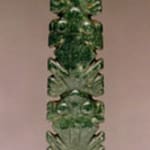Atlantic Watershed Jade Pendant Featuring Four Frogs, 100 CE - 500 CE
Jade
1.5 x 8.25
PF.3136
In the context of Pre-Columbian art and archaeology, jade is a generic term that refers to any variety of hard, dense stones that were worked with great skill by native...
In the context of Pre-Columbian art and archaeology, jade is a generic term that refers to any variety of hard, dense stones that were worked with great skill by native artists. Although jade is generally thought to be green, it can actually be a range of colors. Jade carving flourished in ancient Costa Rica for over a thousand years, roughly from 500 B.C. to 900 A.D., although the period of greatest artistic accomplishment lasted from 300 to 700 A.D. It is believed that jade working began during an extended period of agricultural abundance that allowed the ancient society to dedicate part of its energies toward the cultivation of artistic pursuits.
Jade was considered to be a sacred material by the ancient populations of Costa Rica, held in even higher esteem than gold. Generally, it was thought to symbolize that vital life force that sustains us all. The color green is naturally associated with verdant plant life. Specifically, jade was thought to symbolize the sprouting maize plant, that staple of the Pre-Columbian diet. It has also been suggested that jade represents water. Either way, we can be certain that jade represented the very essence of life itself.
To date, no native sources of jade have been discovered in Costa Rica, suggesting an extended trade network existed that imported this precious resource from Mesoamerica into Costa Rica where it was carved by local artists. Such trade also would have brought great wealth and likely reinforced the social stratification of the peoples. Jade may have served as a status marker to distinguish the elite from the masses and solidify their hold on power. We can picture an ancient ruler or shaman presiding over a sacred ceremonial adorned in brilliant green jade pendants and jewelry. The ancient Costa Ricans believe that the system of social hierarchy also extended into the afterlife. Therefore, jade objects were buried with the elite so that their power could be maintained throughout eternity.
Here, we have before us an exemplary work of unprecedented skill and design. The artist's mastery of lapidary work is clearly demonstrated by the perfect control and symmetry of each stroke. When you hold it in your hands, you can feel the artist's undivided attention and care in each of the smooth crevices along the surface. The frog symbolizes fertility and rain which enables birth, growth and the continuity of life, itself. This important and obviously worshiped symbol is depicted so creatively by the artist. The frogs appear to follow each other from one imaginary infinite point to another creating the illusion of eternity and symbolizing the continuity of life. There are two holes drilled on either side of the pendant to be worn by a special ruler during a fertility ceremony or ritual in honor of the rains. The lush green color of the stone and the artist's exemplary talent combined with the symbolism of the frog creates a masterpiece unsurpassed by its contemporaries.
Jade was considered to be a sacred material by the ancient populations of Costa Rica, held in even higher esteem than gold. Generally, it was thought to symbolize that vital life force that sustains us all. The color green is naturally associated with verdant plant life. Specifically, jade was thought to symbolize the sprouting maize plant, that staple of the Pre-Columbian diet. It has also been suggested that jade represents water. Either way, we can be certain that jade represented the very essence of life itself.
To date, no native sources of jade have been discovered in Costa Rica, suggesting an extended trade network existed that imported this precious resource from Mesoamerica into Costa Rica where it was carved by local artists. Such trade also would have brought great wealth and likely reinforced the social stratification of the peoples. Jade may have served as a status marker to distinguish the elite from the masses and solidify their hold on power. We can picture an ancient ruler or shaman presiding over a sacred ceremonial adorned in brilliant green jade pendants and jewelry. The ancient Costa Ricans believe that the system of social hierarchy also extended into the afterlife. Therefore, jade objects were buried with the elite so that their power could be maintained throughout eternity.
Here, we have before us an exemplary work of unprecedented skill and design. The artist's mastery of lapidary work is clearly demonstrated by the perfect control and symmetry of each stroke. When you hold it in your hands, you can feel the artist's undivided attention and care in each of the smooth crevices along the surface. The frog symbolizes fertility and rain which enables birth, growth and the continuity of life, itself. This important and obviously worshiped symbol is depicted so creatively by the artist. The frogs appear to follow each other from one imaginary infinite point to another creating the illusion of eternity and symbolizing the continuity of life. There are two holes drilled on either side of the pendant to be worn by a special ruler during a fertility ceremony or ritual in honor of the rains. The lush green color of the stone and the artist's exemplary talent combined with the symbolism of the frog creates a masterpiece unsurpassed by its contemporaries.



